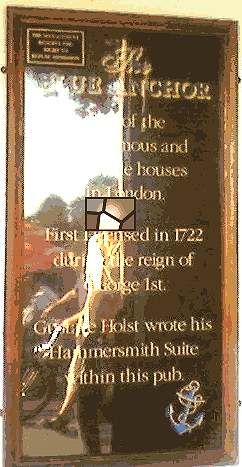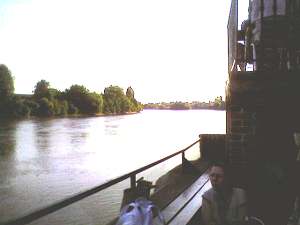HOLST – An Enigmatic
Variation by John France
Summer evenings are
the time for sitting by the riverside
and sipping a glass of Pinot Grigiot
or more appositely a pint of Fuller’s
Chiswick Ale. And there is not a better
place to enjoy this refreshment than
on the riverside at Hammersmith. This
is not the article to explore pub-crawling
by the Thames but my favourite pub is
The Dove. This is a lively, old, traditional
place with an impressive list of drinkers
including Graham Greene, Ernest Hemingway
(he drank everywhere) and A.P. Herbert.
If you can find Herbert’s book The Water
Gypsies you are in for a treat.
James Thomson who allegedly wrote the
words to Rule Britannia lodged
here and William Morris lived next door.
But the most persistent story is that
King Charles II used to have secret
liaisons with Nell Gwynne here ...
So it was with some
sense of history that we sat and reflected
on Music and Literature and enjoyed
the view up and down the Thames. We
knew that Frank Bridge mulled over his
great tone poem Summer near here
and of course across the river in Barnes
are to be found the one-time homes of
Sir Arthur Bliss, Herbert Howells and
William Blezard. But perhaps it is with
Gustav Holst that most musical people
associate Hammersmith.
So we drank up our
bitter and wine, took a couple of ‘snaps’
of the river and headed back towards
the famous bridge. Our next stop was
the Blue Anchor – a small pub that is
about as close to the river as you can
get. My only problem with this hostelry
is the plastic beer ‘glasses’ issued
for use outside – so inside it was.

There is a definite
‘rowing fraternity’ feel in this pub,
and I imagine that it is virtually impossible
to get a drink on boat-race day. The
pub itself has starred in a number of
screen productions including the film
Sliding Doors and made a cameo
appearance in the great TV series Minder.
Yet it is for Gustav Holst that we came
here. A web page review states that
"Holst wrote some old bit of music
here" and we needed to investigate.
Fortunately the notice
board in the doorway gives us all the
information we required – or did it?
Read carefully - "Gustave Holst
wrote his Hammersmith Suite within
this pub." Now I am not a learned
authority on the music of Holst, but
I do pride myself on knowing most of
his orchestral music. One of my earliest
introductions to his work was the St
Paul’s Suite, written for the eponymous
girl’s school just up the road from
the Blue Anchor. And of course I have
known the Hammersmith Prelude and
Scherzo in its orchestral and wind
band versions for years more than I
care to recall. But the Hammersmith
Suite?
Gustav Holst had taken
up residence on the other side of the
river - you can still see the house
where he lived - in a rather lovely
situation close to Barnes Bridge Station.
He lived there for some forty years.
In 1904 he was appointed as the Musical
Director at St Paul’s Girls School across
the river in Hammersmith. It was a journey
he must have made many times as he kept
that post until his death in 1934. It
is well known that he had a sound-proof
room built at the school specifically
for his personal use in teaching and
composing. Nearly all the music of the
last three decades of his life was written
there.
Now back to the notice
board at the Blue Anchor. Holst’s first
composition as head of music was the
St Paul’s Suite, composed in
1913. This was a somewhat ‘flexible’
work that was composed originally for
strings but had a number of wind parts
added in the event of a bigger orchestra
being available. The ‘Suite’
is in four movements – a Jig, an Ostinato,
an Intermezzo and the well known Dargason.
This last movement was an arrangement
of the final movement of the earlier
Second Suite for Wind Band of
1911. Look out for the clever use of
the wonderful old tune Greensleeves.
But good and local as this music is
I guess that this is not the work alluded
to in the pub sign.
It goes without saying
that the notice-board was not referring
to the Moorside Suite. This attractive
and perhaps little known work was composed
for the BBC and the National Brass Band
Festival Committee. Especially worthy
of note is the lovely ‘Nocturne.’ It
has been said that this music has the
tenderness and warmth that seemed to
elude Holst for most of his life and
perhaps heralded a new dawn for his
music. The first movement is a scherzo
- it is perhaps less of a ‘joke’ than
a musical portrayal of a walking trip
over the downs with RVW. The last movement
nods towards the famous ‘Marching
Song’. For the record, this suite
has been arranged for strings by Gordon
Jacob and is perhaps equally as impressive
as the ‘brass’ original. But we decided
that this was not the work alluded to.
There are precious few bits of moorland
near Hammersmith.
The last ‘suite’ that
sprang to our minds was the thoroughly
enjoyable Brook Green Suite written
in 1933. It was composed whilst the
composer was in hospital with stomach
problems and was written for the junior
girls at St Paul’s School. The story
goes that Holst wished to write a piece
that reflected the ‘modern idiom’ yet
was not beyond the ability of the pupils.
It was certainly not a condescending
work as even the most cursory hearing
will confirm. But it is well written
and does not present insurmountable
technical difficulties. It has been
suggested that Holst named the work
‘Brook Green’ because a) it was close
to the school or b) because he was married
nearby. Sadly the first performance
of this work was the very last concert
that Holst attended.
But we had still not
solved the mystery. The last possibility
was the Hammersmith Prelude &
Scherzo. Holst received a commission
to compose a work for the BBC Military
Band. We are on safer grounds now. Apparently
this work was written as a tribute to
the district of London where Holst had
spent much of his life. In part, it
is a musical expression of the sights
and sounds and images and moods of the
River Thames as it passes through Hammersmith.
 Imogen
Holst has written that the work was
the result of much meditation on the
‘changing crowds and the changing river.’
Perhaps it is not quite as programmatic
as parts of Vaughan Williams' London
Symphony, but Holst’s Scherzo certainly
reveals a bustling quarter of the capital.
It does not take much musical imagination
to conjure up pictures of crowds at
the University Boat Race or perhaps
the ‘buzz’ of Broadway on market day.
But it is the Prelude that sets
the scene of this work. Musical critics
have long insisted that it suggests
the river flowing past Hammersmith Bridge
and the pubs on the riverside. Holst
has said that the Thames ‘goes on its
way unnoticed and unconcerned’. Perhaps,
as we listen to the opening music of
Hammersmith we must imagine the
Blue Anchor is closed for business:
maybe it is early on a Sunday morning
and two lovers are slowly walking beside
the river enjoying a few precious moments
before he catches a train. Or maybe
it is a dark winter’s night and the
mist is rolling past the embankment
and the moored houseboats …
Imogen
Holst has written that the work was
the result of much meditation on the
‘changing crowds and the changing river.’
Perhaps it is not quite as programmatic
as parts of Vaughan Williams' London
Symphony, but Holst’s Scherzo certainly
reveals a bustling quarter of the capital.
It does not take much musical imagination
to conjure up pictures of crowds at
the University Boat Race or perhaps
the ‘buzz’ of Broadway on market day.
But it is the Prelude that sets
the scene of this work. Musical critics
have long insisted that it suggests
the river flowing past Hammersmith Bridge
and the pubs on the riverside. Holst
has said that the Thames ‘goes on its
way unnoticed and unconcerned’. Perhaps,
as we listen to the opening music of
Hammersmith we must imagine the
Blue Anchor is closed for business:
maybe it is early on a Sunday morning
and two lovers are slowly walking beside
the river enjoying a few precious moments
before he catches a train. Or maybe
it is a dark winter’s night and the
mist is rolling past the embankment
and the moored houseboats …
Holst re-scored the
work for full orchestra and it was this
version that was premièred in
London in 1931. Apparently it did not
go down too well and was booed. I must
confess that our glass of Pinot Grigiot
and pint of ‘Best’ did go down well
and it was with some difficulty that
we dragged ourselves away from the Blue
Anchor.
The enigma was solved.
An error of musical history had seemingly
invented a ‘new’ work which had all
the potential for an interesting discovery.
But I suppose we were never really in
doubt as to which composition the sign
referred to. However it passed an interesting
hour for us - reflecting on the some
of the best of this great composer’s
music in one of the most evocative parts
of London. And one last thing: look
at the picture - the composer’s Christian
name is spelt Gustave! We cognoscenti
know it was actually Gustavus Theodore
von Holst – or just plain Gustav.
John France

